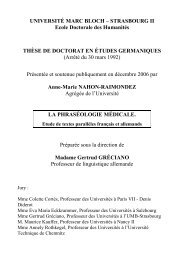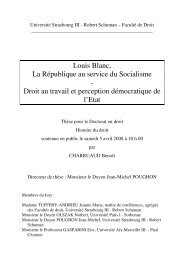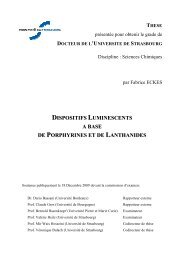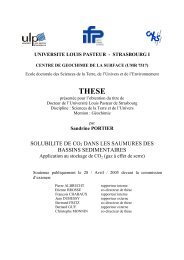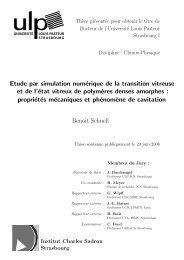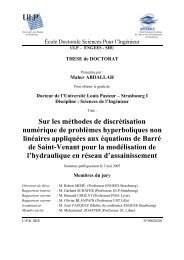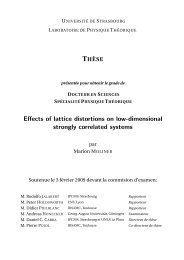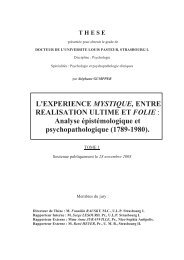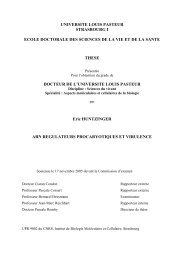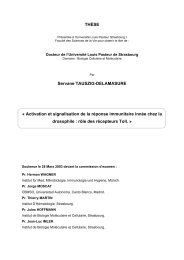Économie Évolutionniste et Culture d'Entreprise
Économie Évolutionniste et Culture d'Entreprise
Économie Évolutionniste et Culture d'Entreprise
You also want an ePaper? Increase the reach of your titles
YUMPU automatically turns print PDFs into web optimized ePapers that Google loves.
que le sens est construit dans le langage, à partir du langage <strong>et</strong> par l’usage du langage. Le développement<br />
du langage reflète l’énaction des connaissances. Ainsi, avant d’avoir acquis ses premiers mots, nous<br />
savons que le jeune enfant communique des intentions à travers ses comportements, puis dans sa voix à<br />
travers son babillage. Si ses intentions sont reconnues <strong>et</strong> comprises par ses pairs, si l’enfant peut prendre<br />
l’initiative d’agir sur les obj<strong>et</strong>s de son environnement, l’enfant peut accéder aux représentations <strong>et</strong> aux<br />
symboles, donc au langage 60 . Le langage perm<strong>et</strong> de transm<strong>et</strong>tre ou de véhiculer les significations dans<br />
l’organisation. Les individus <strong>et</strong> les organisations passent un temps considérable à construire <strong>et</strong><br />
reconstruire la compréhension de leurs actions pour trouver des réponses à leurs problèmes. Mais la<br />
plupart du temps, ces réponses sont données <strong>et</strong> circulent de façon informelle autour de la machine à café<br />
ou lors d’un repas. Dans ce travail de thèse, nous allons considérer une forme principale de ce processus<br />
de transmission des significations : les “histoires organisationnelles” ou “narratives”.<br />
Les “narratives” sont l’expression libre <strong>et</strong> non structurée sur des situations spécifiques. Elles facilitent le<br />
diagnostic des situations vécues <strong>et</strong> réduisent les ruptures lorsque des perturbations interviennent. Un des<br />
exemples les plus célèbres est celui des techniciens réparateurs chez Xerox 61 . Les narratives ont joué un<br />
rôle central dans la dynamique des communautés de pratique chez Xerox. Et c<strong>et</strong>te narrative des “techreps”<br />
de Xerox a eu à son tour un eff<strong>et</strong> notoire ces dernières années sur la révélation de la nature sociale<br />
de l’action <strong>et</strong> de la connaissance dans les théories économiques <strong>et</strong> managériales des organisations.<br />
Weick (1995) voit dans les narratives un instrument explicatif qui perm<strong>et</strong> de construire du sens. Pour lui,<br />
les narratives sont des construits qui aident à expliquer les relations entre les évènements dans un<br />
processus narratif. De plus, en m<strong>et</strong>tant en scène les acteurs, les narratives leur apportent légitimité <strong>et</strong><br />
responsabilité. Les narratives (ou storytelling) servent ainsi à communiquer des connaissances tacites, à<br />
résoudre des conflits, à faciliter la socialisation des nouveaux employés, à stimuler les résolutions de<br />
60 Le premier langage de l’enfant exprime ainsi des actions concrètes sur les obj<strong>et</strong>s. Les mots exprimant ce concr<strong>et</strong> vont<br />
servir de base par projection au langage abstrait : “je m<strong>et</strong>s de l’argent de côté”, “je dois repartir à zéro”, <strong>et</strong>c. La même chose<br />
avec les obj<strong>et</strong>s que l’enfant catégorise au départ en fonction des propriétés qu’il a perçues à travers ses agissements sur les<br />
obj<strong>et</strong>s. Premières catégorisations (formes, couleurs, tailles, textures, <strong>et</strong>c.) qui servent de base aux catégorisations ultérieures par<br />
projection métaphorique: “le cercle des proches du directeur”, “les diverses formes de musique”, “les fruits de son<br />
imagination”, <strong>et</strong>c.<br />
61 “The story begins in the 1980s. We were looking for ways to boost the productivity of the Xerox field service staff.<br />
Before deciding how to proceed, we launched a study. An anthropologist from the Xerox Palo Alto Research Center (PARC), a<br />
member of the work-practices team, traveled with a group of tech reps to observe how they actually did their jobs – not how<br />
they described what they did, or what their managers assumed they did. That research challenged the way Xerox thought<br />
about the nature of work, the role of the individual, and the relationship b<strong>et</strong>ween the individual and the company. It was the<br />
first shot in a revolution. Here’s what the anthropologist saw: Tech reps often made it a point to spend time not with customers<br />
but with each other. They’d gather in common areas, like the local parts warehouse, hang around the coffee pot, and swap<br />
stories from the field. Think how a garden-vari<strong>et</strong>y reengineer would interpr<strong>et</strong> this finding: Here’s “low-hanging fruit” -- easy<br />
pickings for immediate productivity gains. Simply reroute the tech reps, cut out the conversation, eliminate the dead time – and<br />
pock<strong>et</strong> the savings. The anthropologist saw the exact opposite. The time at the warehouse was anything but dead. The tech reps<br />
weren’t slacking off; they were doing some of their most valuable work. Field service, it turns out, is no job for lone wolves.<br />
It’s a social activity. Like most work, it involves a community of professionals. The tech reps weren’t just repairing machines;<br />
they were also coproducing insights about how to repair machines b<strong>et</strong>ter. These technicians were knowledge workers in the<br />
truest sense. And it was through conversations at the warehouse – conversations that weren’t a step in any formal “business<br />
process” or a box in any official “org chart” – that knowledge transfer happened. So Xerox turned conventional wisdom on its<br />
head. Rather than eliminate the informal conversations in pursuit of corporate efficiency, we decided to expand them in the<br />
name of learning and innovation. Using the Denver area as a pilot project, PARC distributed two-way radio heads<strong>et</strong>s to the<br />
tech reps. The radio frequency over which the tech reps communicated became a “knowledge channel” through which they<br />
asked each other questions, identified problems, and shared new solutions as they devised them.” (Brown <strong>et</strong> Gray, 1995, p.<br />
78).



